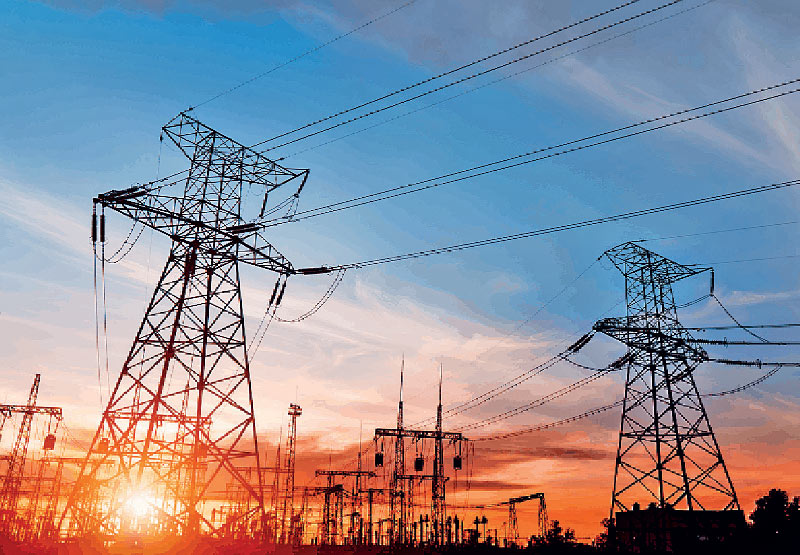Wednesday Jan 07, 2026
Wednesday Jan 07, 2026
Monday, 4 August 2025 03:14 - - {{hitsCtrl.values.hits}}

 From the simple standpoint of prudent State financial solvency and security, it is important that these investments are funded either directly (or indirectly through the local banking system), with new and additional foreign exchange inflows. Even through the local banking system, given capital allocation requirements of banks, single borrower limitations, prudent sectoral limitations, high effective tax rates, etc., direct project financing from overseas would end up being the cheapest source of funding. The caveat being that the sector needs to be suitably structured with strong independent regulatory oversight, to reduce the risks and attract private capital on attractive terms
From the simple standpoint of prudent State financial solvency and security, it is important that these investments are funded either directly (or indirectly through the local banking system), with new and additional foreign exchange inflows. Even through the local banking system, given capital allocation requirements of banks, single borrower limitations, prudent sectoral limitations, high effective tax rates, etc., direct project financing from overseas would end up being the cheapest source of funding. The caveat being that the sector needs to be suitably structured with strong independent regulatory oversight, to reduce the risks and attract private capital on attractive terms
 Sri Lanka’s electricity sector needs considerable transformation. Its structure, culture and technologies are archaic. It is not conducive to delivering the dynamism, competitiveness and efficiencies that a modern economy and consumer demands. The 2024 Act was to set the path and journey towards achieving this, and the proposed 2025 Amendments arguably stifle this process. In whatever form the sector emerges, post the parliamentary debate and vote on the Amendments scheduled for 6 August, the sector is going to require considerable investment to meet whatever objectives the Government ends up with1. This article will focus on the challenges, limitations and sometimes incorrect notions associated with generating the required investment and argue why this investment needs to be both private sector driven, and foreign sourced.
Sri Lanka’s electricity sector needs considerable transformation. Its structure, culture and technologies are archaic. It is not conducive to delivering the dynamism, competitiveness and efficiencies that a modern economy and consumer demands. The 2024 Act was to set the path and journey towards achieving this, and the proposed 2025 Amendments arguably stifle this process. In whatever form the sector emerges, post the parliamentary debate and vote on the Amendments scheduled for 6 August, the sector is going to require considerable investment to meet whatever objectives the Government ends up with1. This article will focus on the challenges, limitations and sometimes incorrect notions associated with generating the required investment and argue why this investment needs to be both private sector driven, and foreign sourced.
To start with we need to recognise that the State has little to no fiscal space for investment. Even the 2024 fiscal targets set under the IMF program were met partly by limiting Capital Expenditure to levels lower than originally budgeted2. The Successor Entities that emerge from the CEB’s restructuring, and that will continue to be State owned, will also have very limited ability to borrow beyond their carved-out balance sheets as any further project debt will be deemed as de-facto sovereign guaranteed for overall State debt calculations.
It is also pertinent to note that the State has multiple priorities for investment. Areas such as education, health, food security, highways, extreme poverty, and not to mention debt reduction, are all areas that have been either historically under-invested in and/or require very long-term funding which only a State tax revenue base can provide. While the overall Energy and Electricity sectors arguably also have been subject to under-investment for decades, these are nevertheless sectors that can be suitably ring fenced from wider sovereign risks given their strong inherent cashflows, and have shorter gestation and payback periods compared to some of the above areas of priority. Hence these sectors are well suited for private, as opposed to State, financing3.
Investment will require foreign exchange
The second if not more important challenge is that investment into these sectors will require foreign exchange. There is often the misconception that if projects can be locally financed that it eliminates the need for foreign exchange, and thereby repayments of foreign exchange, be it debt or equity. The reason this is dangerously fallacious is that projects typically require up to 70-80% of their costs to be imported either as capital goods or even technical services. Locally financed or not, the nation still needs to find foreign exchange for this. Based on the investment requirement over the next five years1, this amount could range between $ 10-12 billion. This is a large amount in relation to the already precarious Gross National Reserve position of approx. $ 6 billion and targeted Reserves of $ 15 billion by 2028.
Hence from the simple standpoint of prudent State financial solvency and security, it is important that these investments are funded either directly (or indirectly through the local banking system), with new and additional foreign exchange inflows. Even through the local banking system, given capital allocation requirements of banks, single borrower limitations, prudent sectoral limitations, high effective tax rates, etc., direct project financing from overseas would end up being the cheapest source of funding. The caveat being that the sector needs to be suitably structured with strong independent regulatory oversight, to reduce the risks and attract private capital on attractive terms.
There have been several countries that have successfully done so and raised capital for their energy sectors in recent times at terms more attractive than their respective sovereigns. India, Chile, Jordan, Mexico, Morocco, South Africa are all nations that have raised capital either directly into projects or via Green Bonds at premiums up to 200 basis points (2%) lower than their respective sovereigns4.
The next misconception is one of ownership. That private and/or foreign ownership of energy assets (be they generation, transmission or distribution) may compromise energy security. Firstly, regulatory or state capture, be it by vested interests of the private sector or for that matter the State sector (trade unions for example) is a function of either a weak State or weak Regulator. Hence this danger must be addressed by adequate Regulatory independence and competence, robust antitrust and conflict of interest laws, and adequate competition leading to adequate disaggregation and number of players in the system. Therefore the dangers of State or Regulatory capture are agnostic to private or state ownership.
Foreign ownership of renewable energy generation entities
Secondly, with transitioning to more renewable energy resources, nations further eliminate the risks of being beholden to offshore supply chains for inputs and associated risks for continued energy supply, as the input resource is domestically available. During force majeure incidents like a global pandemic or a financial crisis, a State can both physically and legally ensure continuity of the functioning of the assets without having to rely on external inputs or cross border transactions. Such provisions can be enshrined in legality. Hence foreign ownership of renewable energy generation entities (or transmission and distribution for that matter) do not add any additional or exceptional risks with respect to energy security verses any local ownership of the same.
Lastly, the benefit of private ownership is competition. Competition leads to better price discovery which means more efficient capital allocation and the optimal prices for end using consumers and industries. But very importantly, there must be adequate competition. Else it will only lead to perpetuating cronyism at best, leading to discrediting the overall thesis for private ownership. This in turn further subjects a nation to seek dependencies of the State, leading to a vicious cycle of perpetual inefficiency and eventual insolvency. This is a paradigm not unique to the electricity sector alone. It is common to most if not all economic sectors. Hence the overall energy sector architecture must embody all the necessary elements to create this competitive environment. And policy makers must genuinely and honestly believe in this for it to be realised.
The 2024 Act set the pathway for the beginning of the journey for this architecture. The 2025 proposed Amendments unfortunately seem like a regression from this. Firstly, they dilute the independence of the Regulator from political imperatives. A clear red flag for bona fide investors and capital providers. As described earlier this will only lead to fewer investors and bidders and increased risk premiums, leading to unnecessarily higher tariffs.
The amendments also eliminate the ability to bring private sector investment into either transmission or distribution, either by restrictions or an imperative for 100% government ownership. Thus, shutting the door for achieving one of the primary objectives of attracting offshore private capital, the justification for which was articulated above.
The amendments also run the risk of retaining the bundled nature of the entity, perpetuating the inefficiencies, the lack of a performance-based culture and State capture by trade unions that have long plagued the sector, the elimination of all which was the founding policy objective of the original reforms.
Footnotes:
1.For example, over the next 5 years energy transition to renewables would require up to USD 9bn of investment. CEB’s own plans call for Pump Hydro Project financing of approx. USD 800m. Further Transmission line enhancements would require up to USD 2bn.
2.2024 budgeted capital expenditure was 1,701bn and actual spend was 815bn. Primary account balance of LKR approx. 650bn hit and exceeded the target of LKR 240bn partly by virtue of this capex reduction.
3.The 2024 Act strengthens regulatory oversight of the Electricity sector requiring the Regulator to ensure the sector entities’ “financial sustainability”.
4.For example, a 100bps drop in cost of capital (and risk premium) can lead to a 5-7% drop in a prospective tariff for a solar plant
(The writer is former Country Head of Fitch Ratings, has spent many years in Private Equity, is currently an Independent Director of Nations Trust Bank, and was formerly the Chief of Party of the USAID Sri Lanka Energy Program.)